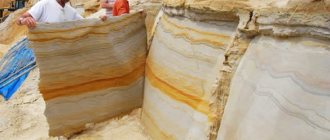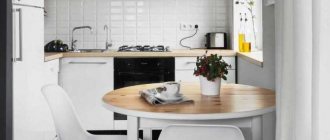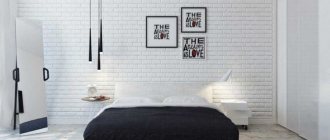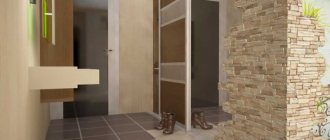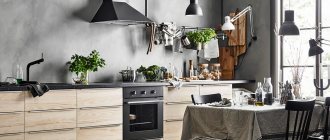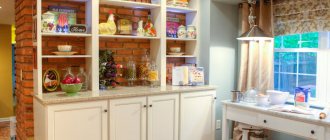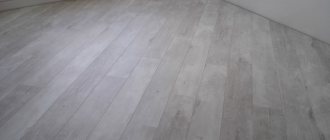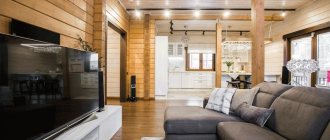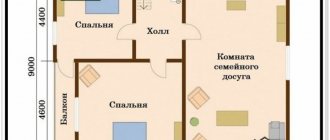High-quality laying of decorative bricks in rooms and non-residential premises of an apartment or private house can complement any design style. Owners can choose for use both materials used for facade cladding and inexpensive wall panels and tiles. First of all, owners are advised to determine how much each type of product costs. After selecting suitable materials, you need to calculate the number of products required for cladding. Owners will also have to buy auxiliary tools and consumables. It is not difficult to carry out cladding in a new building or renovate an old home yourself, following the recommendations of specialists. Careful preparation and compliance with basic requirements will help you easily carry out the renovation without the involvement of craftsmen and get an original design for all rooms of your home.
History and modernity
Brickwork in interior design has gained popularity thanks to lofts. Initially, the former factory premises were given to poor tenants who could not invest in a full renovation with plastering and painting.
This is how raw walls, which can be seen in old photos, came into fashion. Students and young families not only lived in such premises, but also held noisy parties with the participation of guests from various social classes.
This new direction in design became associated with bohemianism, industrialism and freedom, which appealed to city residents. Nowadays, brick wall decoration is again very popular, and can be used in combination with various styles.
You can also achieve an appearance that imitates brickwork using 3D wallpaper from picwalls.ru
Snow-white brickwork
Advantages and disadvantages
Any finish has its strengths and weaknesses. Let's get to know them before we start implementing our ideas.
Advantages: accessibility and simplicity
The undeniable advantages of using brick in the interior include:
- Financial inclusion.
- Safety.
- Naturalness.
- Good performance properties of the material (sound insulation, thermal insulation, moisture resistance).
- Ease of finishing. The design process using bricks allows you to cope with the task even without special skills and complex tools.
- You can use this approach in arranging almost any room.
- A brick wall can perform not only a decorative, but also a practical function - serve as a delimiter between rooms.
- Possibility to use hanging elements - shelves, lighting fixtures, TV, etc.
- Additional surface treatment is not necessary.
- Possibility of masking wall defects.
- Originality.
- Durability.
- Texture.
- Good compatibility with natural colors and natural materials.
- Decorative finishing.
Additional wall treatment is not necessary
Disadvantages: the main thing is to stop in time
There are quite a lot of advantages to this type of finishing. But what are the disadvantages?
The disadvantages of a brick wall in the interior of a house include:
- Untreated natural-colored brick needs high-quality lighting. As an alternative, you can use white brick or paint it.
- An uneven textured surface is difficult to clean.
- Too much brick in the interior design of a house can create the effect of an unkempt and cold room that lacks coziness.
An uneven surface is more difficult to maintain
The brick wall should be an original accent, and not occupy all the walls.
Real masonry or imitation: what to choose?
In addition to using real brick, its imitation, wallpaper of suitable colors or tiles of appropriate stylization can be used.
Real brick wall
In this case, the masonry made from floor to ceiling is not subject to additional plastering or hiding under sheets of plasterboard. For a spacious room with high ceilings, one of the walls of the room can be left without additional covering.
Made from real brick
But processing must be present:
- The masonry is cleaned of dust and solution residues.
- They wash.
- Grinding.
- The joints are rubbed using putty or grout.
- Possible varnishing or painting.
Decorate the living room to your taste
Wallpaper with print
The simplest and most financially uncomplicated way of decoration is wallpaper with a corresponding pattern. The effect of masonry can be created not on the entire wall, but only on certain areas, for example, niches or wall fragments. Wallpapering can be combined with other decorative materials:
- decorative putty;
- natural wood;
- tiles.
Wallpaper with a pattern
Attention should be paid to the selection of colors and expressiveness of texture. The best effect is created by high-quality design material. Separately, it should be noted that the textured wallpaper can be painted. You can even give them the desired shade yourself.
High-quality wallpaper that imitates brick can be used in places that are inconvenient for decoration with other materials:
- narrow niches;
- on surfaces that have a bevel;
- on uneven surfaces, etc.
Excellent imitation
Advice A wide field for realizing ideas is provided by photo wallpapers that combine a “brick” background with another print, for example, graffiti.
Facing brick
Facing materials are currently presented very widely. It is lighter and thinner, compared to standard brick, takes up less free space and has a low weight . This circumstance allows the use of this facing material for finishing thin walls and in cases where it is important to economically manage free space.
The material can be:
- artificially aged;
- matte;
- treated with glaze.
Cladding materials are very popular
Brick-like tiles
Brick veneer has an even thinner thickness compared to facing bricks. Tiles can be of two main types:
- clinker;
- ceramic.
Before laying, the wall surface must be pre-leveled.
Interior design element
Independent production of cladding material
In addition to the listed options, imitation brick can be made independently. This requires molds, varnish and brick plaster. This option can be used if you need to create an unusual design using bricks of a non-standard format.
Selection of material
Recently, stone finishing has become even more popular. Therefore, the question of choice is becoming increasingly acute for consumers. Among the many types and types of finishing in this class, it is necessary not to make a mistake with the texture, origin, size, and other qualities of decorative stone cladding.
Popular materials: stone slabs and artificially made blocks.
- The first category includes granite, marble, dolomite, sandstone, dense-textured limestone, quartzite and others.
- In the second - flexible, gypsum, cement and other materials.
When choosing, you must adhere to the following rules:
- Compliance with the chosen interior style and color scheme.
- Reliable protection against mechanical influences.
- Moderation, since the abundance of stone on the walls makes the room heavier, making it more like a crypt or utility room.
Natural
Various natural materials can be used to decorate these areas of the wall surface.
It is necessary to note the high price of the elements that create a continuous corner, which are carved from a larger workpiece. Therefore, when facing, they often use ordinary straight slabs, but with trimming the contacting elements at 45°. When two adjacent slabs are connected to each other at the cutting points, their outer layer creates the impression of a monolithic stone surface.
Such work is a highly complex installation and requires the use of an electric tile cutter . But it is still cheaper than purchasing special corner monolithic elements made from natural material.
Artificial
Cladding with artificial decorative stones is significantly cheaper than with natural analogues. First of all, this is due to the lower price of raw materials, since even special corner elements are cheaper than direct analogues of natural origin. But attaching them to walls is a little more difficult. It is necessary to correctly and evenly apply the mortar to the surface of the tile or wall so that a minimum of voids is formed.
More convenient options for artificial stones are available as flexible ones. They can be used to cover even sharp corners, without damaging the decorative layer as a result of bending the fabric base. The strength of the elastic coating is not much lower than its harder counterpart, since the outer layer contains up to 90% marble, granite chips or other mineral particles.
Visual effects: how to influence the perception of space?
A wall made of traditional red brick is not the only possible option. The texture of the material and the laconic form of individual elements allows you to influence the perception of space. How to do it?
White wall
This option is used so often that it requires separate mention. Texture combined with white creates a good background for placing bright accessories.
White wall in the kitchen
The versatility of the shade allows it to be used in any room as the main design or to highlight individual zones. In white it is even possible to decorate all the walls in the room.
And at the same time the room will not look gloomy and basement. On the contrary, a light shade “adds” free space, making the room visually larger. Most often this technique is used when decorating bedrooms and kitchens.
Looks good in any room
Painting it white makes the design modern and dynamic.
When is this required?
Previously, in order for the corner to have a completed beautiful shape, it was trimmed with plastic or other special corners. Today this method is considered outdated and is viewed with doubt. A more sophisticated, organic solution is required. Similarly, tiles of adjacent walls placed end to end on the outer corners do not give the desired picture.
It is best to use special corner elements . Even if their price is slightly higher than standard material, the visual effect will be much richer and more refined: it will suit any interior style. In addition to the beautiful appearance, the absence of seams in such problem areas will ensure a long service life of the cladding and will protect the ends of the tiles from destruction.
In the photo below you can see what a hallway looks like with this cladding:
These are other photos of the internal corner cladding:
Photos of the design of the external corners of the house:
We combine the incongruous
A brick wall is original, impressive and fashionable. But how can you choose the rest of the design as organically as possible?
Designers advise:
- Very often such a wall combines several shades. In this case, it is better to select furniture using the darkest and lightest colors as a basis.
- The rigor of the design can be enlivened by a bright carpet or eye-catching accents, such as colorful pillows on the sofa.
- Red brick color goes well with orange, yellow, and blue. This combination is especially effective in oriental ornaments.
Video description
A master class on creating a “brick” wall from polystyrene foam is presented in the video:
But this material has a significant drawback: it is very fragile, fragile, and does not withstand mechanical stress well.
You can also cut rectangular parts to the size of a brick from other materials - wood, foam concrete and gas silicate blocks. Or make them from gypsum or cement mortar, pouring them into special molds that you can buy or make yourself.
Molds for manufacturing and finished bricks Source images.ua.prom.st
Brick in the living room interior: creating extraordinary effects
Decorating the living room with brickwork allows you to give the room a fashionable touch. The originality of this finish allows you to make the wall the main decorative element.
The larger the space in the living room, the more organic and impressive the brick wall will look. The combination with a light ceiling and wooden ceiling beams will give it style.
Organically fit into the interior
The spirit of antiquity is emphasized by the brick design of the space near the fireplace, the walls between the window openings and even the central wall. In addition to walls, brick can be used in partitions, fireplaces, etc.
Dark brick in the interior must be balanced with light shades. This can be done using furniture, textiles, and accessories.
Dark brick needs to be diluted with light furniture
Tip The presence of a fireplace in the living room can be played up by highlighting a part of the wall near it with appropriate design.
Brick in the kitchen interior: a variety of options
The safety and durability of brick allows it to be used in the interior design of many rooms. In the kitchen it can be used in doses, allowing you to create an accent where it is needed.
Kitchen apron
This wall area is regularly exposed to steam, soot and grease. The apron occupies the space between work surfaces and wall cabinets.
Non-standard solutions
In order to facilitate the cleaning process, designers suggest adding a glass sheet to the exterior of the brickwork . This technique will preserve decorativeness and protect surfaces.
One of the walls
Decorating one of the walls with brick will look most impressive in an interior with a predominance of warm light shades:
- milky white;
- light gray;
- caramel;
- soft pink;
- cocoa shade.
Accentuating one of the walls
Part of the wall
Selecting a fragment of a wall looks no less impressive. Most often, this design is used for the dining area. In small rooms, this technique will allow you to delimit zones.
Niche
A natural or decorative niche lined with brick will help emphasize the historical orientation of the design, stylization of a rustic design, Provence style, etc. If a niche is formed near the stove, this will add retro touches to the decor.
Option for execution in the kitchen
Advice In addition to the listed options, a column in the room, a partition, a place near the bar counter, etc. can be decorated with brick.
What difficulties may arise?
To ensure easier and more reliable installation of corner elements, it is necessary to extend the finishing coating in this area. If the linings are heavy or made of natural stone, then you need to use special adhesives and prepare the surface more responsibly.
Finishing corners with decorative stone is the most difficult part in installing decorative stone. If natural materials are used, then specially made corner elements are not always used. This makes installation slightly more difficult, since it requires an electric tile cutter and the ability to operate it. If all the requirements for finishing with decorative stone are met, you can install such cladding on the corners yourself.
Brick in the bedroom interior
Brick in the design of a bedroom can be used to emphasize the character of the finish. Most often, in a bedroom, one wall or an area near the head of the bed is bricked.
Tip To add the sophistication characteristic of Provence or to endow the room with romantic features, painting the brickwork with light paint can be used.
We bring ideas to life
Styles: choosing a design option
Brick is distinguished by its versatility as a finishing material. Its use is most justified when decorating an apartment in the following styles: loft, country, Provence, etc. Such design of vertical surfaces is impressive and relevant.
Loft
Housing organized on the territory of former production premises, workshops or factories is characterized by a large area and high ceilings. These advantages allow you to implement design techniques that are not always acceptable in small apartments. These include wooden ceiling beams, columns, and brick decoration.
Loft style
The loft allows you to leave open electrical cables, heating pipes and other elements that highlight the technical engineering equipment of the house. Bricks are also a suitable backdrop for placing video and audio equipment.
Country
A style that uses natural materials and naturalness in design goes well with the design of country houses. The comfort of simple interiors with fireplaces and natural materials is emphasized by a brick tub combined with wood. This design is associated with relaxation and outdoor recreation.
Country style
Gothic
This trend dates back to the Middle Ages. The Gothic style uses brick in decoration in combination with forged parts of furniture and accessories.
Minimalism
Red brick, brown, white and gray colors should go well with the overall design - ceiling, floor and furniture.
When nothing is too much
Grunge
Mixing several styles and design trends allows you to introduce the most whimsical elements into the interior. The stylishness achieved in this way can become a distinctive feature of your home, and emphasize its dissimilarity with the homes of friends and acquaintances.
Ecostyles
Unity with nature, the use of wood, stone and natural fabrics in the design allows you to create a very cozy home. Brick, with its emphasized environmental friendliness, can become one of the components of such an interior.
We create cozy housing
High tech
Far from the word “ecologically friendly,” urban high-tech can also be combined with brickwork. Most often, imitation tiles are used for it.
Classic English interior
The emphasized rigor of design and correctness of English classics can be combined with brick elements. The touch of aristocracy and style inherent in medieval castles of the English nobility can be accentuated by the use of brick decoration.
Refresh with a light sofa
How to do styling - step by step instructions
Preparing the walls
Before installation, the following conditions must be met::
- level, plaster, prime the surface to be finished;
- the area must be finished in a certain order and volume so that the finish does not sag under the weight of the glue and coating;
- the appearance of individual stone tiles depends on the viewing angle;
- Smooth surfaces will create an artificial finish, so a certain asymmetry must be maintained in the horizontal and vertical directions.
Preparation of materials
The material is fixed with different adhesives depending on the type of decorative stone:
- special mixtures for stone;
- adhesive composition for tiles;
- silicone glue;
- liquid nails.
When using conventional cement-sand mortar, a small amount of plasticizer is added. Most often, PVA glue is used for this purpose. Then the adhesion of the decorative stone to the surface being finished will be stronger.
The adhesive composition should have a homogeneous creamy consistency.
How to lay out the walls?
Instructions for installing decorative stone at corners:
- The prepared, cleaned walls are covered with a deep penetration primer until completely dry.
- If there are several packages, they need to be mixed so that there is no difference in color.
- The adhesive composition is mixed in the required proportion with an electric drill with a mixer attachment until a homogeneous consistency.
- Finishing is done from the very corner, using corner elements or trimmed tiles. The thickness of the applied adhesive layer should not exceed 1 cm.
- The tile should be slightly pressed when placing it on the wall to create an even surface layer, then the remaining adhesive mixture will come out. They must be immediately removed from the walls and decorative parts of the tiles.
- When laying in joints, regular tile crosses are used, but thicker ones.
- The jointing is done with a construction syringe for adhesive mixtures, and the joints are filled with a solution of no more than 5 mm. This work must be completed no later than 24 hours from the date of installation.
If there are special ready-made adhesives for a particular material, it is necessary to use them, since they contain elements in specified proportions that will ensure reliable adhesion of the coating to the wall.
Using bricks: tips and tricks
How to preserve masonry and avoid tarnishing and defects?
Real brick is beautiful in itself, has a pronounced texture and a characteristic shade. How to preserve it without losing quality characteristics and color? For this, interior designers advise using special protective compounds.
If there is a lack of light, which occurs, for example, in a hallway, the wall can be varnished with a slight glossy effect. This will ensure color preservation.
In sunny rooms, you can varnish with a matte effect. Such protection will be completely invisible, but at the same time quite reliable.
In an industrial interior
Is old brick good or bad?
The old brick wall looks historic, attractive in its rugged beauty. But for the interior it must first be put in order. For this purpose, brushing is used. You may need to wipe the stained areas with a mixture of vinegar and water.
Advice: Before using aggressive cleaning agents, check the condition of the brick. A crumbling surface cannot be treated this way.
With the effect of old brick
High humidity: how to overcome it?
In rooms where there is often high humidity, such as a bathroom, protecting the brickwork comes first. To do this, the crumbled seams are deepened a couple of centimeters, and then restored with a new solution. The next step is sealing to protect against mold.
Protecting brickwork
How to veneer a corner with decorative stone - recommendations, photos, simple step-by-step instructions
Corners in a room have always been the most difficult surface elements to finish. If gluing wallpaper or other materials somehow managed to ensure their uniform coverage, then laying decorative stone has many difficulties. Special elements are produced in some series of stone finishing for corners, but such elements are more expensive and more difficult to install.
Work on mistakes
Using such a simple and yet quite complex material, it is necessary to take into account some features of brick:
- Once the wall is painted, it is extremely difficult to remove the paint if necessary. This is due to the porosity of the structure and good absorption.
- It is not advisable to completely highlight a long wall with brick. In this case, it must be “broken” with pieces of furniture, mirrors or decor. This way it will be better perceived visually.
- Mirrors reflecting a brick wall will help unite the space of the room into a single ensemble.
- The paintings look very beautiful on brick walls. The more there are, the more attention is drawn to the wall itself.
- Hanging open shelves hung on such a wall add coziness. Their color and material are selected taking into account the style of the room.
Bright accent
VIDEO: How can you use brick on a wall?
Brick wall
Ideas for your interior
Wallpaper
Yes, you read that right. Wallpaper has come a long way over the years, and brick print wallpaper is no exception. Easy to use and can be applied by a non-trained person, but now available in textured options. You will love the charm they add to your home. Find some great inspiration below.
